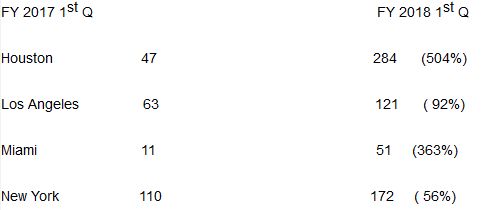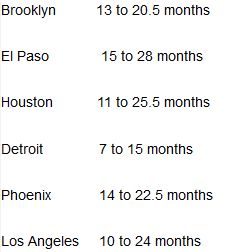In order to uphold the "integrity of our nation's immigration system," on October 1, 2017, U.S. Citizenship and Immigration Services (USCIS) began to phase-in a mandate of in person adjustment of status (I-485) interviews for employment based cases at USCIS field offices nationwide. Previously, USCIS field offices would rarely interview an employment based adjustment applicant. Prior to 1992, however, the legacy Immigration and Naturalization Service (INS) would routinely interview employment based adjustment applicants. So, there is some precedent for the policy.
On May 1, USCIS published its performance statistics related to adjustment of status applications for the first quarter of the 2018 federal fiscal year, which commenced on October 1, 2017. These statistics are just beginning to reflect the impact of these interview changes at the USCIS field office level. For initial comparison, however, it is obvious that staffing challenges for USCIS will become more dire:
Employment based adjustment applications approved – Service Center level

In March of 2018, USCIS announced that it was testing a new method to calculate its processing times of various applications, including the I-485 adjustment application. USCIS created a new website page for reviewing the processing times of its forms. This announcement came in the wake of a report from the U.S. Department of Homeland Security's (DHS) Office of the Inspector General (OIG), entitled, "USCIS Has Unclear Website Information and Unrealistic Time Goals for Adjudicating Green Card Applications." The OIG report noted that:
- USCIS was not meeting its goal of adjudicating adjustment applications in 120 days.
- Since fiscal year 2011, the overall average number of days it takes to complete adjustment applications increased to more than twice the goal.
- The published calendar date on the former processing time system had nothing to do with the actual receipt date of the applications by Immigration Service Officers (ISO). In addition, the date did not reflect how long an application was taking to be adjudicated by an officer at one of the 86 USCIS field offices.
A sample of current posted processing times for adjustment applications reflects the following, with the note excerpted below:
This time range is how long it is taking your office to process your case from the date we received it. We generally process cases in the order we receive them, and we will update this page around the 15th of each month. Please note that times may change without prior notice.

What should employers be doing with this information?
Due to the problems associated with international travel and delays in adjustment adjudications, it is critical to assess field office caseloads and processing times especially in comparison to consular immigrant visa processing. Employees engaged in international work for their U.S. employers often are unable to remain in the U.S. for extended periods of time waiting for work authorization and travel documents to be issued. An adjustment based work authorization/travel document combination card can easily take 4 to 5 months to adjudicate. In addition, with most adjustment applications taking at least a year, if not almost two years to adjudicate, a consular application process with all of its various steps can begin to look pretty attractive for some cases.
In comparison to the timeline above, consider the following recent time frame we experienced through a consular application filed with the U.S. Consulate in Cd. Juarez:
- ETA-9089 approved 07/05/2017
- I-140 filed 11/16/2017 approved 11/24/2017 with premium processing
- National Visa Center fee bills dated 12/29/2017
- Packet III submitted 01/29/2018
- Appointment Notice: April 2, 2018
- Interview date: May 18, 2018
So, about eleven months, but since the underlying nonimmigrant status allowing work authorization continued, the applicant did not have his/her international travel interrupted and the end result of an immigrant visa was achieved during a shorter time frame than most current adjustment applications reviewed by USCIS field offices.
This analysis requires constant updating and can change quickly, but it merits the investment of time to consider the best path with all facts on the table.
The content of this article is intended to provide a general guide to the subject matter. Specialist advice should be sought about your specific circumstances.
